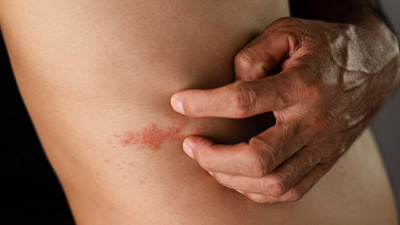Shingles (herpes zoster) is a painful skin disease that is caused by the (varicella zoster virus), which also causes chicken pox (varicella). Shingles is always a reactivation of the virus in the body. Therefore, it must be proceeded by an initial infection with chicken pox. The varicella can be reactivated by stressful situations, influenza or a weakened immune system
Overview
Shingles, also known as herpes zoster, is a viral infection caused by the varicella-zoster virus, which is also responsible for chickenpox. Once a person has had chickenpox, the virus lies dormant within nerve cells in the body. Years or even decades later, it can then be reactivated and cause shingles.
The disease is characterised by a painful skin rash that typically manifests as a stripe of blisters on one side of the body or face. These blisters are filled with a clear fluid and can be highly itchy or painful. Other symptoms include fever, headache and a general feeling of being unwell.
It is important to understand that shingles itself is not infectious in the same way as chickenpox. However, a person with shingles can transmit the varicella-zoster virus to people who have not yet had chickenpox or have not been vaccinated against it. These individuals can then develop chickenpox as a result. Contact with open shingles blisters should therefore be avoided, particularly in order to protect people with a weak immune system, pregnant women and babies.
Occurrence & causes
The exact cause of the reactivation of the varicella-zoster virus is not fully understood, although it is assumed that a weakened immune system plays a key role. Factors that can weaken the immune system include:
- Older age
- Stress
- Certain medications and diseases that compromise the immune system, such as HIV/AIDS or cancer
Course of the disease
Shingles typically begins with pain, itching or a tingling sensation in a specific area of the skin. A few days later, red patches appear on the skin and quickly develop into small, fluid-filled blisters. These blisters burst and crust over to form scabs that heal within a few weeks. Shingles is usually limited to one side of the body and commonly occurs in the chest area, although it can also affect other parts of the body.
The disease is generally harmless and tends to clear up within two to four weeks with no lasting damage. The characteristic skin rash recedes even without treatment, although it can lead to changes in the skin – such as darkening when exposed to sunlight or a loss of pigment – in some cases. In children, shingles is very rare and generally uncomplicated, whereas adults are more likely to suffer severe pain.
Although the disease is typically harmless, complications can occur in some instances. Herpes zoster is particularly problematic in the facial area, as there is a risk that it may affect the eye. This can lead to serious consequences, such as retinal detachment.
Symptoms
The symptoms of shingles can vary, but the most common are:
- Severe pain, a burning sensation, numbness or tingling in the affected region
- A red rash that appears after a few days
- Blisters that burst and then crust over
- Itchiness
- Fever, headache and fatigue can also occur
In some cases, shingles can lead to complications such as postherpetic neuralgia, a lasting disorder in which pain persists even after the skin rash has healed.
Symptoms usually occur on the chest and torso and less frequently on the neck, arms or legs – and are limited to the area of skin supplied by the affected nerve cord.
Diagnosis
Shingles is generally diagnosed based on the characteristic rash and pain. In the absence of external symptoms that clearly point to herpes zoster, the disease can also be diagnosed by means of lab tests. Even tiny quantities of the varicella-zoster virus, which causes the disease, can be detected by a polymerase chain reaction (PCR) test. In this technique, a small amount of viral DNA is replicated and analysed. If there are no blisters on the skin, the test can even be performed using a blood sample.
Treatment
The treatment of shingles aims to relieve pain and speed up the healing process. Treatments include:
- Antiviral medications: these can shorten the course of the disease and reduce the severity of symptoms, particularly if taken at an early stage.
- Painkillers: from simple analgesics to specialised drugs for nerve pain.
- Caring for the skin rash: use of lotions and cold compresses to relieve itchiness.
- Rest and recuperation: sufficient rest is important to allow the body to heal.
Prevention
The prevention of shingles is particularly important for older people. One effective means of prevention is vaccination against the varicella-zoster virus. This vaccination is particularly recommended for people over the age of 50, as the risk of shingles and associated complications increases with age. It is also important to strengthen the immune system by maintaining a healthy lifestyle with a balanced diet and regular exercise.



